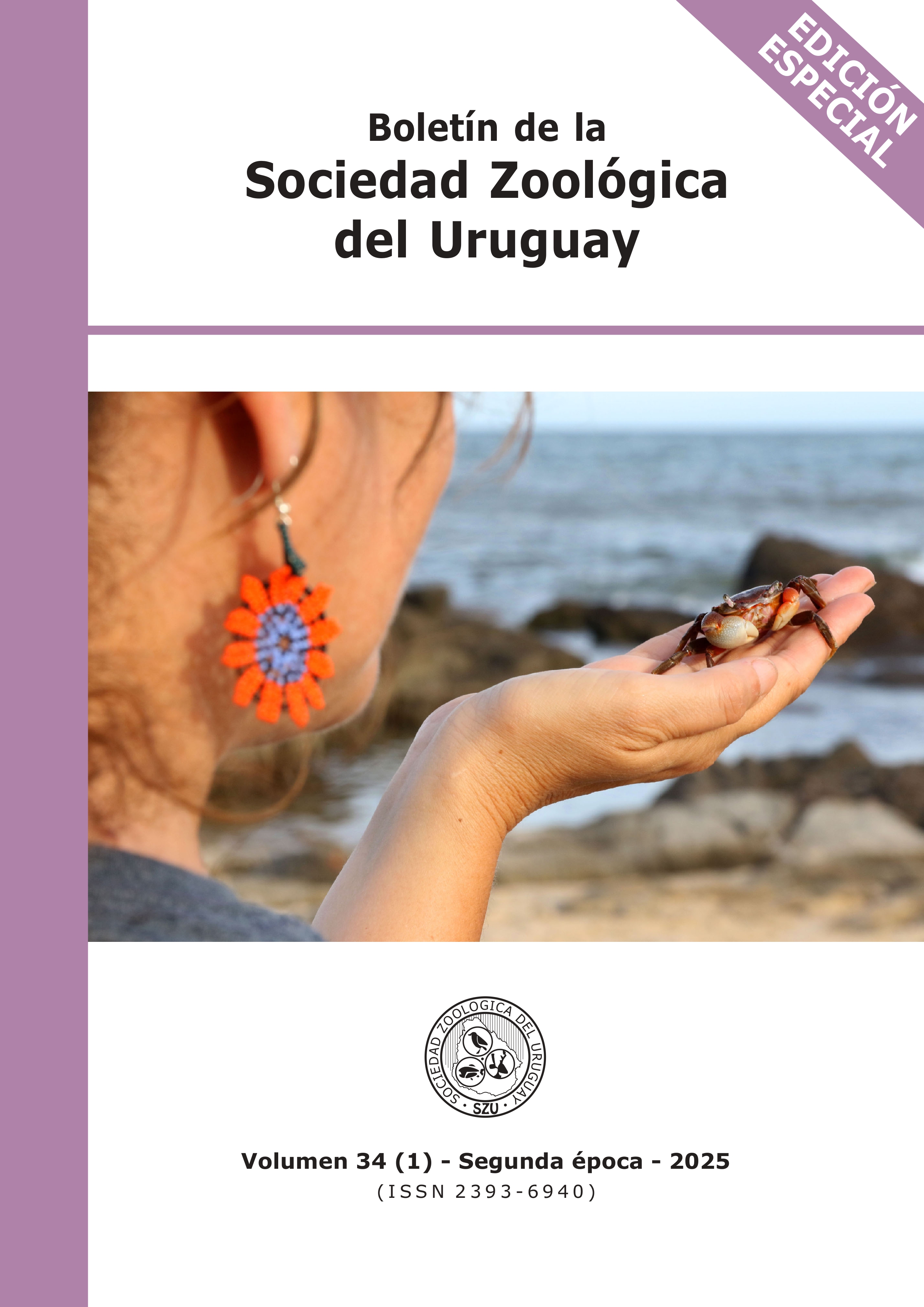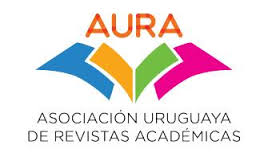MUCH MORE THAN HONEY: BEES FROM URUGUAY. SCIENTIFIC COMMUNICATION FOR CHILDREN
DOI:
https://doi.org/10.26462/34.1.21Keywords:
Scientific communication, bees, pollination, biodiversity, childrenAbstract
When we face science communication, the strategies to cover child audiences are a great challenge. In 2020, a group of five female researchers studying bees at different research institutions in Uruguay decided to create a book on Uruguayan bees. Its objective was to promote their valuation, their essential role in natural ecosystems, and to raise their awareness. Thanks to the collaborative work, we generated a disclosure tool of 83 color pages with information on Uruguayan bee species, for which there was no accessible material for the general audience in our country. Fifty illustrative sheets of scientific concepts and information on bee biodiversity were generated, with 30 proposals for games and activities to paint, complete, interpret, and search for. Furthermore, thanks to the collaboration of different institutions and individuals, since 2022, more than 8,500 books have been distributed free of charge in 238 educational centers and to more than 420 private individuals in the 19 provinces of Uruguay. This project has promoted the visibility of a group of organisms with an essential activity in nature, in a non-traditional format to awaken the love for science and nature in future generations.
Downloads
References
Antúnez, K., Invernizzi, C., Mendoza, Y., van Engelsdorp, D., & Zunino, P. (2016). Honeybee colony losses in Uruguay during 2013-2014. Apidologie, 48, 364-370.
Antúnez, K., Anido, M., Branchiccela, B., Harriet, J., Campa, J., Invernizzi, C., … Zunino, P. (2015). Seasonal variation of honeybee pathogens and its association with pollen diversity in Uruguay. Microbial Ecology, 70, 522-533.
Antúnez, K., Anido, M., Branchiccela, B., Harriet, J., Campá, J., & Zunino, P. (2012). American foulbrood in Uruguay: Twelve years from its first report. Journal of Invertebrate. Pathology, 110, 129-131.
Arbulo, N., Invernizzi C., Salvarrey, S., & Santos E. (2011). “Effect of Proboscis Length on Resource Utilization in two Uruguayan Bumblebees: Bombus atratus Franklin and Bombus bellicosus Smith (Hymenoptera, Apidae)”. Neotropical Entomolology, 40(1), 72-77.
Arbulo, N., Antúnez. K., Salvarrey, S., Santos, E., Branchiccela, B., Martín-Hernández, R., Higes, M., & Invernizzi, C. (2015). High prevalence and infection levels of Nosema ceranae in bumblebees Bombus atratus and B. bellicosus from Uruguay. Journal of Invertebrate Pathology, 130, 165-168.
Ashman, T., Knight, T. M., Steets, J.A., Amarasekare, P., Burd, M., Campbell, D. R., Dudash, M.R., Jongston, M.O., Mazer, S.J., Mitchell, R.J., Morgan, M.T., & Wilson, W.G. (2004). Pollen limitation of plant reproduction: ecological and evolutionary causes and consequences. Ecology, 85, 2408-2421.
Barth, F. (1991). Insects and flowers: the biology of a partnership. New Jersey: Princeton University Press. 204p. Bianchi, S., & Carrau, A. (2023). Sector apícola: situación y perspectivas. En “Anuario OPYPA 2023”. Disponible en https://descargas.mgap.gub.uy/OPYPA/Anuarios/Anuarioopypa2023/A NUARIOOPYPA2023.pdf
Borges, R.M., Gowda, V., & Zacharias, M. (2003). Butterfly pollination and high-contrast visual signals in a low-density distylous plant. Oecologia, 136, 571-573.
Buchmann, S.L., & Nabhan, G.P. (1996). The forgotten pollinators. Island Press, Shearwater Books. Washington DC. 292p.
Ceibal. (2024). https://bibliotecapais.ceibal.edu.uy/info/mucho-mas-que-miel-abejas-del-uruguay-00022686?utm_campaign=2409_Ceibal_Biblioteca_brand&utm_content=ad_text&utm_medium=cpc&um_source=Google_Search Fecha de consulta: 18 de diciembre de 2024
Chaplin-Kramer, R., Sharp, R.P., Weil, C., Bennett, E. M., Pascual, U., Arkema, K.K., ... & Daily, G.C. (2019). Global modeling of nature's contributions to people. Science, 366(6462), 255-258.
Cordara J. (2005). La historia de la apicultura en Uruguay. Facultad de Ciencias Agrarias Universidad de la Empresa. Montevideo Uruguay.
Invernizzi, C., Santos, E., García, E., Daners, G., Di Landro, R., Saadoun, A., & Cabrera, C. (2011). Sanitary and nutritional characterization of honeybee colonies in Eucalyptus grandis plantations in Uruguay. Archivos de Zootecnia, 60, 1303-1314.
Invernizzi, C, Zefferino, I., Santos, E., Sánchez, L., & Mendoza Y. (2016). Multilevel assessment of grooming behaviour against Varroa destructor in Italian and Africanized honeybees. Journal of Apicultural Research, 54, 1-7.
Invernizzi, C., Antúnez, K., Arredondo, D., Branchiccela, B., Castelli, L., Juri, P., Mendoza, Y., Noguerira, E., Salvarrey, S., & Santos, E. (2022). Situación sanitaria de las abejas melíferas en Uruguay: Novedades de la última década. Veterinaria (Montevideo), 58(217), e20225821704.
IPBES. (2016). The assessment report of the Intergovernmental Science-Policy Platform on Biodiversity and Ecosystem Services on pollinators, pollination and food production. S.G. Potts, V.L. Imperatriz-Fonseca, and H.T. Ngo, (eds). Secretariat of the Intergovernmental Science-Policy Platform on Biodiversity and Ecosystem Services, Bonn, Germany. 552 pp.
Kevan, P.G. (1999). Pollinators as bioindicators of the state of the environment: species, activity and diversity. Agriculture, Ecosystems and Environment, 74, 373-393.
Klein, A.-M., B.E. Vaissie `re, J.H. Cane, I. Steffan-Dewenter, S. A. Cunningham, C. Kremen, & T. Tscharntke. (2007). Importance of pollinators in changing landscapes for world crops. Proceedings of the Royal Society of London B, 274, 303-313.
Massarani, L. (1999). La divulgación científica para niños. Quark, 40-45.
Massarani, L. (2004). La divulgación científica para niños: revista" Ciencia Hoje das crianças" de la Sociedad Brasileña para el Progreso de la Ciencia. El libro informativo en América Latina. Educación Y Biblioteca, 141, 78-82.
MEC (2024). https://www.gub.uy/ministerio-educacion-cultura/sites/ministerio-educacion-cultura/files/documentos/noticias/Mucho%20mas%20que%20miel_%20abejas%20de%20Uruguay%20digital_opt.pdf Fecha consulta: 18 de diciembre de 2024
MGAP. (2021). https://www.gub.uy/ministerio-ganaderia-agricultura-pesca/datos-y-estadisticas/datos/sinatpa-informe-datos-delregistro-nacional-propietarios-colmenas Fecha de consulta: 18 de diciembre de 2024.
Michener, C.D. (2007). The Bees of the World. Johns Hopkins University Press. 913p.
Niell, S., Jesús, F., Díaz, R., Mendoza, Y., Notte, G., Santos, E., … & Heinzen, H. (2018). Beehives biomonitor pesticides in agroecosystems: Simple chemical and biological indicators evaluation using Support Vector Machines (SVM). Ecological Indicators, 91, 149-154.
Niell, S., Jesús, F., Pérez, N., Pérez, C., Pareja, L., Abbate, S., … & Heinzen, H. (2017). Neonicotinoids transference from the field to the hive by honeybees: Towards a pesticide residues biomonitor. Science of the Total Environment, 581, 25-31.
Palacios, S., Santos, E., & Tomasco, I. (2021). Scientific note: southernmost record of Mourella caerulea and evidence of old and gradual colonization to the south. Apidologie, 52(2), 309-311.
Potts, S.G., Biesmeijer, J.C., Kremen, C., Neumann, P., Schweiger, O., & Kunin, W.E. (2010). Global pollinator declines: trends, impacts and drivers. Trends in ecology & evolution, 25(6), 345-353.
Potts, S.G., Imperatriz-Fonseca, V., Ngo, H.T., Aizen, M.A., Biesmeijer, J.C., Breeze, T.D., ... & Vanbergen, A.J. (2016). Safeguarding pollinators and their values to human well-being. Nature, 540(7632), 220-229.
Requier, F., Antúnez, K., Morales, Garrido, A., Giacobino, F., Reynaldi, J., Rosso Londoño, J.M., Santos, E., & Garibaldi, L.A. (2018). Latin America, Journal of Apicultural Research, 662, DOI: 10.1080/00218839.2018.1494919.
Salvarrey, S., Arbulo, N., Santos, E., & Invernizzi, C. (2013). “Cría artificial de abejorros nativos Bombus atratus y Bombus bellicosus (Hymenoptera, Apidae)”. DOI: 10.31285/AGRO.17.478. Agrociencia Uruguay, 17(2), 75-82.
Salvarrey, S., Arbulo, N., Rossi, C., Santos, E., Salvarrey, L., & Invernizzi, C. (2017). Utilización de abejorros nativos (Bombus atratus Franklin y Bombus bellicosus Smith) para mejorar la producción de semillas del trébol rojo (Trifolium pratense). Agrociencia Uruguay, 21(1), 95–104.
Salvarrey, S., Arbulo, N., Santos, E., & Invernizzi C. (2020ª). Constancia floral en los abejorros nativos Bombus pauloensis y Bombus bellicosus. Boletín de la Sociedad Zoológica del Uruguay, 29(2), 126-131. DOI: 10.26462/29.2.9.
Salvarrey, S., Santos, E., Arbulo, N., Gimenéz, G., & Invernizzi C. (2020b). Characteristics of the tomato fruit (Solanum lycopersicum) using native bumblebees (Bombus atratus) as pollinators in greenhouse. Agrociencia Uruguay, 24(1),1-10.
Salvarrey, S., Antúnez, K., Arredondo, D., Plischuk, S., Revainera, P., Maggi, M., & Invernizzi, C. (2021). Parasites and RNA viruses in wild and laboratory reared bumble bees Bombus pauloensis (Hymenoptera: Apidae) from Uruguay. PLoS ONE, 16(4), e0249842.
Sánchez, A.M. (1998) La divulgación de la ciencia como literatura, Ciudad de México, Universidad Autónoma de México. 36p Santos, E., Arbulo, N., Salvarrey, S., & Invernizzi, C. (2017). Distribución de las especies del género Bombus Latreille (Hymenoptera, Apidae) en Uruguay. Revista de la Sociedad Entomológica Argentina, 76(1), 22–27.
Santos, E., Morelli, E., & Galván, G. (2020). Recortes de hoja de soja (Glycine max Merril) son utilizados para construcción de nidos de abejas nativas (Hymenoptera: Apidae), Megachilinae de Uruguay. Boletín de la Sociedad Zoológica del Uruguay, 29(2), 183-186.
Santos, E., Daners, G., Morelli, E., & Galván, G.A. (2020). Diversity of Bee Assemblage (Family Apidae) in Natural and Agriculturally Intensified Ecosystems in Uruguay. Environmental Entomology, 49(5), 1232-1241.











